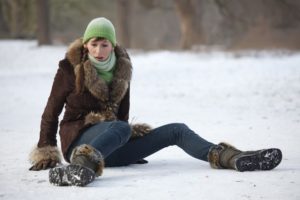
I grew up in the Toronto area and then went to school in Kingston before settling in Ottawa. When I moved here to begin my career, everyone was going on about how cold it is. I remember thinking, “How bad can it be? It’s not that far from Kingston.” Obviously meteorology and weather patterns are not my strength. Suffice to say I learned what “lake effect” truly meant.
Aside from the cold, one of the things that I have found most surprising is how much freezing rain we get here. It isn’t an isolated phenomenon. It happens all the time. What’s with that? You would think that if we have to endure the extreme cold we could dodge the freezing rain bullet. Obviously this is not the case.
Whether it be due to freezing rain or packed down snow, I see clients all winter who have fallen outdoors. Unfortunately there are an even greater number of people who fall and don’t get treatment. You might wonder why you should seek physiotherapy treatment if you have fallen but weren’t injured aside from a bruise or two. Let me make the case for you to reconsider this thinking.
There’s More Going on than just Bruising
When we fall, the areas of the body that hit the ground sustain impact. This is really no different than getting hit by a baseball bat in terms of force sometimes. When muscles get hit they seize up. We all are probably familiar with the term “Charlie horse”, which refers to a knot in the thigh muscles that occurs after we get hit with something. Well knots in muscles occur with any impact.
Usually bruising occurs but once that clears up the pain goes away and we continue on our merry way thinking everything is fine. The problem is the pain goes away but the tightness in the muscle does not. In order to compensate for the muscle that isn’t working properly we then change the way we move. Other muscles try to pick up the slack by overworking. This puts us at risk of subsequent problems such as tendonitis and excessive joint wear and tear as the load is no longer spread evenly.
In short, when one part is not pulling its weight, another body part has to work harder and we will eventually pay for this in some form. The tight muscles for some reason don’t let go on their own after the trauma is over. They need some hands-on physiotherapy treatment to do so, otherwise they can hang on indefinitely. I have seen clients who have had tight muscles from impacts they received decades earlier.
If you have had a recent fall, poke around in the muscles where you sustained the impact and I guarantee you will find some nasty knot in there somewhere that is quite sore to push on. This needs to be worked out manually.
Shock Waves Cause Problems on the Opposite Side
The other little-known effect of falling is on the opposite side from the impact. This side absorbs the shock waves as they spread through the body away from the site of impact. They also cause muscles to tighten up to essentially hold us together as the shock waves try to send everything everywhere. I often see just as much, if not more, tightness on the opposite side from where the person fell. This too needs physiotherapy treatment to get things moving properly again.
Near Falls Cause Problems Too
But what if you just slipped and didn’t actually fall. Picture a cartoon character with all four limbs flailing trying to keep from going down or check out this poor gentleman. Pretty much every muscle in your body kicks in at full force as you try to prevent hitting the ground. I have seen cases where this has wreaked more havoc on a body than actually falling. Muscles everywhere get tight from contracting violently and in some cases joints can get pushed to extreme positions in the effort. When I see people in this situation they often start with a statement like, “This may seem crazy……” It’s not crazy if you hurt everywhere after a near fall. There is good reason for it.
If you have had a recent fall or near fall, or even an incident that happened a long time ago, deal with the tight muscles before the problem snowballs. We would be happy to help.